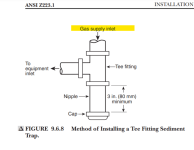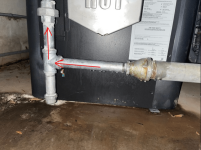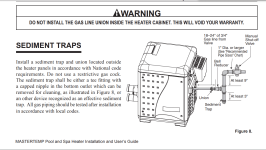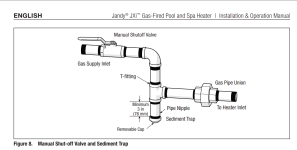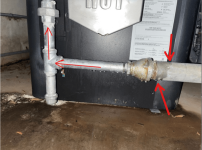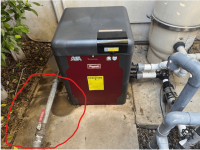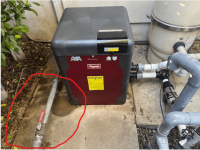16 years. With the top vent, the heater let a lot of rainwater in and the last rainstorm finally rusted it out too far to repair.How long did your previous heater last?
condensation on my new heater's gas line
- Thread starter bad144
- Start date
You are using an out of date browser. It may not display this or other websites correctly.
You should upgrade or use an alternative browser.
You should upgrade or use an alternative browser.
If you look at the daylight pic there is no green or white. I don't know why the flash makes it look that way, there is not much to see. Yes I think I see a little white on the concrete in the back corner, probably from the old heater. There is no algae, just ficus leaves that keep blowing into the area.The white on the ground looks like calcium scale from a leak.
The green looks like algae from the area staying wet all of the time.
Did the old heater leak?
The old heater didn't leak.
9.6.8 Sediment Trap. Where a sediment trap is not incorporated as a part of the appliance, a sediment trap shall be installed downstream of the appliance shutoff valve as close to the inlet of the appliance as practical at the time of appliance installation.
The sediment trap shall be either a tee fitting with a capped nipple in the bottom outlet, as illustrated in Figure 9.6.8, or another device recognized as an effective sediment trap.
Illuminating appliances, gas ranges, clothes dryers, decorative appliances for installation in vented fireplaces, gas fireplaces, and outdoor cooking appliances shall not be required to be so equipped.
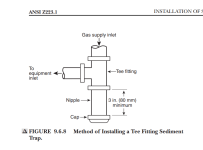
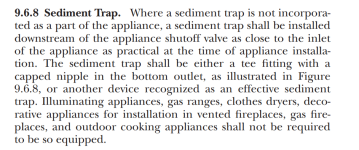
The sediment trap shall be either a tee fitting with a capped nipple in the bottom outlet, as illustrated in Figure 9.6.8, or another device recognized as an effective sediment trap.
Illuminating appliances, gas ranges, clothes dryers, decorative appliances for installation in vented fireplaces, gas fireplaces, and outdoor cooking appliances shall not be required to be so equipped.


Hmm, condensation seems to have nearly stopped with water temp above 74 or so (pipes still wet but concrete is now dry). Concrete is grey/brown mix to the eye but shows up with a green tint with LED lighting. Iphone seems to just be screwing up color space.
Yes, that's what the installer added. Tee. Nipple. Cap. Check.9.6.8 Sediment Trap. Where a sediment trap is not incorporated as a part of the appliance, a sediment trap shall be installed downstream of the appliance shutoff valve as close to the inlet of the appliance as practical at the time of appliance installation.
The sediment trap shall be either a tee fitting with a capped nipple in the bottom outlet, as illustrated in Figure 9.6.8, or another device recognized as an effective sediment trap.
Illuminating appliances, gas ranges, clothes dryers, decorative appliances for installation in vented fireplaces, gas fireplaces, and outdoor cooking appliances shall not be required to be so equipped.
View attachment 548590
View attachment 548591
- Feb 6, 2015
- 7,949
- Pool Size
- 12300
- Surface
- Plaster
- Chlorine
- Salt Water Generator
- SWG Type
- CircuPool RJ-45 Plus
Look at your gas line routing and that of the diagram in post 23 and the previously provided diagrams.Yes, that's what the installer added. Tee. Nipple. Cap. Check.
They are vastly different.
In post 23, the gas comes in from the top, the line to the heater goes out to the side and the sediment trap out the bottom.
Your gas line comes in from the side, the line to the heater goes out the top and the sediment trap out the bottom.
Additionally, your gas line that close to the side exhaust is dangerous.
Regardless of the condensation, your gas line isn't correct.
Last edited:
I didn't see anything in the quoted text or descriptions that says the supply has to come from the top. I don't think that's a reasonable interpretation but I'm certainly no expert.Look at your gas line routing and that of the diagram in post 23 and the previously provided diagrams.
They are vastly different.
In post 23, the gas comes in from the top, the line to the heater goes out to the side and the sediment trap out the bottom.
Your gas line comes in from the side, the line to the heater goes out the top and the sediment trap out the bottom.
Additionally, your gas line that close to the side exhaust is dangerous.
Regardless of the condensation, your gas line isn't correct.
Yes, it doesn't seem to be working right to have the exhaust that close to the supply line. I do note that it's the manufacturer that put the gas inlet 2.5" from the vent... Perhaps not a very good design.
According to this:I didn't see anything in the quoted text or descriptions that says the supply has to come from the top. I don't think that's a reasonable interpretation but I'm certainly no expert.
Yes, it doesn't seem to be working right to have the exhaust that close to the supply line. I do note that it's the manufacturer that put the gas inlet 2.5" from the vent... Perhaps not a very good design.

Improper gas line sediment trap installation - Inspectagator
We don’t experience a plethora of gas appliance installations in Central Florida. As you may expect, when we do come across gas lines, we sometimes find improper sediment trap installations. And although they may have been present for many years, it doesn’t mean it’s ok and it’s safe. As you can...
 inspectagator.com
inspectagator.com
I checked the rest of my house and none of my furnaces or tankless heaters have sediment traps to compare with, LOL.
No, I believed the equipment swap was a minimal emergency changeover. I thought he'd use a flexi-line for the heater actually. I have a whole house tankless heater using one even. Likewise with a whole house gas generatorMost references show the gas supply coming in from the top.
In my opinion, that is the correct way to do it.
Some references only say to provide a change of direction, which your does, so some people might argue that it is acceptable.
Did you get a permit and an inspection for this installation?
View attachment 548596
I identified the missing sediment trap issue and had him add one for extra credit. None had been put in place before with everything permitted and inspected in the past so that system is not working around here anyways. In any case, that sediment trap article I quoted I think clears up the rabbit hole of the sediment trap and that's not my issue here.
Last edited:
No, I believed the equipment swap was a minimal emergency changeover. I thought he'd use a flexi-line for the heater actually. I have a whole house tankless heater using one even. Likewise with a whole house gas generator...
I identified the missing sediment trap issue and had him add one for extra credit. None had been put in place before with everything permitted and inspected in the past so that system is not working around here anyways. In any case, that sediment trap article I quoted I think clears up the rabbit hole of the sediment trap and that's not my issue here.
I think that a permit is required.No, I believed the equipment swap was a minimal emergency changeover.
A complete replacement is not considered to be "Minimal" and I do not know how a pool heater replacement can be considered to be an "Emergency".
In any case, you can reroute the line to avoid the drip.
The exhaust should be mostly going out of the top and not the bottom.
Does the hot exhaust hit the line and cause it to heat up?
Maybe you can create some sort of shield for the line or maybe coat it with a paint or epoxy to protect the line from corrosion.
The amount of water being produced seems excessive to me, but I do not know what would cause that much water.
- Jul 21, 2013
- 66,419
- Pool Size
- 35000
- Surface
- Plaster
- Chlorine
- Salt Water Generator
- SWG Type
- Pentair Intellichlor IC-60
I think your only problem is the gas line passing in front of the exhaust vent.
Getting condensate when heating cold water is typical for most pool heaters. There is discussion of condensate freezing on exhaust vents in the manual.
The manual says "Care must be taken when locating the heater outdoors, because the flue gases discharged from the vent cap can condense as they leave the cap."
You even said condensation seems to have nearly stopped with water temp above 74 or so. That is all normal behavior.
Rerouting the gas line or extending the exhaust vent will fix things.
You never really showed us the overall environment the heater sits in. From this pic it looks like the heater sits close to a wall and there is planting near the exhaust. You may not have very good airflow circulation around the exhaust that allows it to sink towards the floor instead of rising up.

Getting condensate when heating cold water is typical for most pool heaters. There is discussion of condensate freezing on exhaust vents in the manual.
The manual says "Care must be taken when locating the heater outdoors, because the flue gases discharged from the vent cap can condense as they leave the cap."
You even said condensation seems to have nearly stopped with water temp above 74 or so. That is all normal behavior.
Rerouting the gas line or extending the exhaust vent will fix things.
You never really showed us the overall environment the heater sits in. From this pic it looks like the heater sits close to a wall and there is planting near the exhaust. You may not have very good airflow circulation around the exhaust that allows it to sink towards the floor instead of rising up.
It is really not in front of the vent, it is below the vent.I think your only problem is the gas line passing in front of the exhaust vent.
I would contact Raypak and get their opinion on the installation including the gas line and the amount of water being produced.
You should register the heater for warranty purposes.
Was this installed by a licensed gas contractor?
Was the installer a certified Raypak authorized installer?
Was the installer a pool company, HVAC company, Plumber, handyman or what?
Since they did not get a permit, they probably are not qualified to pull permits for this type of installation.
Qualified contractors get the required permits and inspections.
Unqualified people who advertise on Craigslist do not get permits.
Contact Us – Raypak
Raypak Pool & Spa, Residential and Commercial Hydronic Products -
Tech Corner – Raypak
Raypak Pool & Spa, Residential and Commercial Hydronic Products -
- Jul 21, 2013
- 66,419
- Pool Size
- 35000
- Surface
- Plaster
- Chlorine
- Salt Water Generator
- SWG Type
- Pentair Intellichlor IC-60
How is the line wet all the way back to the arrows?
In various places the manual warns of condensate from the exhaust and that it can drop to the floor.
For example on page 8...

There are 25 mentions of condensate in the Avia Installation Manual to signal that they realize the heater produces condensate in the exhaust and it needs to be managed.
It still seems excessive to me.In various places the manual warns of condensate from the exhaust and that it can drop to the floor.
Maybe it is ok, but I would check with Raypak to get their opinion.
Thread Status
Hello , This thread has been inactive for over 60 days. New postings here are unlikely to be seen or responded to by other members. For better visibility, consider Starting A New Thread.


